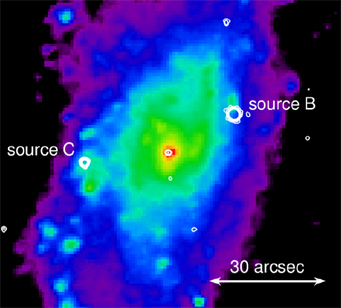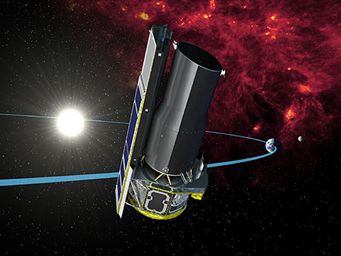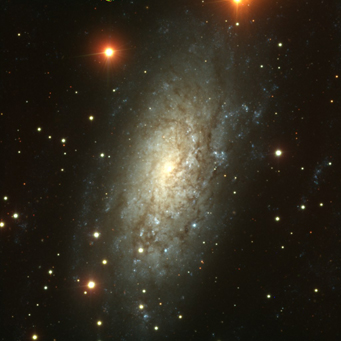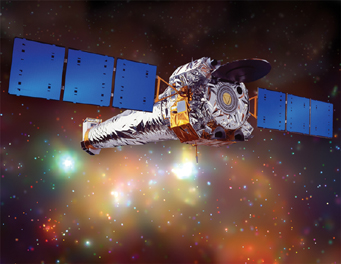As far as we know, every galaxy that has a central bulge of old stars harbors a monster in its core: a supermassive black hole with anywhere from a million to 20 billion times the mass of the Sun.
But younger, bulge-less galaxies don’t have them. So astronomers are scouting these for smaller, still-growing black holes — the missing links between the little black holes that form from collapsing stars and the monsters in galaxy cores.

In this image of the galaxy NGC 3621, false colors represent infrared radiation seen by Spitzer, and white contour lines represent X-ray intensity seen by Chandra. The possible central black hole appears in red in the middle. Two other candidate black holes are marked "source B" and "source C." The 30-arcsecond scale bar corresponds to 3,200 light-years at the galaxy's distance of 22 million light-years.
Gliozzi et al.
For at least the second time now, a team reports a bulge-less galaxy with a possible midsize black hole — or three of them.
“One of the keys for understanding how supermassive black holes grow is understanding whether lower-mass black holes exist in large numbers, since they could be the seeds for the more massive ones,” says black hole expert Karl Gebhardt (University of Texas at Austin).
Shobita Satyapal (George Mason University) searched infrared images from NASA’s Spitzer Space Telescope for preliminary hints of black-hole activity in the center of young galaxies. The spiral NGC 3621, 22 million light-years away in Hydra, proved a good candidate.
NGC 3621 is too young to have collided with many other galaxies, as evidenced by its lack of a central bulge and by its elegant spiral arms still packed with gas. Galaxy mergers tend to scatter stars into random orbits — eventually forming a smooth central bulge — and to compress gas into creating new stars.

Artist's concept of the 0.85-meter infrared Spitzer Space Telescope on its Sun-centered orbit.
NASA / JPL-Caltech
In a recent research article, Satyapal, Mario Gliozzi (George Mason University), and collaborators report on their results using NASA’s Chandra X-Ray Observatory satellite. “The X-rays confirmed the presence of the accreting black hole,” Satyapal says.
The black hole at the center of NGC 3621 could be one of the missing links: a young, mid-sized specimen on a feeding frenzy. At about 20,000 solar masses “It’s what most people would consider an intermediate-mass black hole,” says David Merritt (Rochester Institute of Technology), who did not take part in the study.

NGC 3621, some 22 million light-years away in Hydra, as seen in by one of the four units of the the Very Large Telescope at Paranal Observatory in Chile.
F. Bresolin, R.-P. Kudritzki, R. Mendez (Institute for Astronomy, Univ. Hawaii)
A black hole's mass can be estimated from the luminosity of its surrounding accretion disk across many wavelengths. In this case, the team had to introduce a fudge factor: they had to assume that less-energetic X-rays are obscured by gas, in order to explains the relatively low luminosity of the accretion disk at those wavelengths.
“[That's] certainly possible, but it’s a hard case to make,” Merritt claims, stressing the resulting uncertainty in the mass estimate. Gebhardt agrees: “There could be alternative explanations. The jury is still out and will require additional data (as the authors suggest).”
Another question also remains: “We don’t know what are the seeds of supermassive black holes,” Gliozzi says. But more research might help reconstruct their growth. “If you had several objects of this kind, you could find a sequence,” says Gliozzi.

Artist's concept of the Chandra X-Ray Observatory.
CXC / NGST
Black-hole expert John Kormendy (University of Texas at Austin) suggests that the seeds are low-mass stellar holes that formed from collapsing stars very early in the universe’s history. “The natural picture is that they got formed in large numbers early on,” says Kormendy. Building a central monster from one of these seeds would involve the accretion of a lot of gas falling into the galaxy's center and perhaps mergers of multiple holes themselves, as entire galaxies merge and their dense cores sink to the middle.
This is speculative, but it might explain why Gliozzi’s team seems to see not one, but three black holes in NGC 3621. The X-ray source at the center of the galaxy is flanked by two others about a thousand light-years on either side, which the team also interprets as intermediate-mass black holes.
 1
1
Comments
Lindsay S.
June 16, 2009 at 7:56 am
Woooow. Really interesting!!!!!!!!!!
You must be logged in to post a comment.
You must be logged in to post a comment.